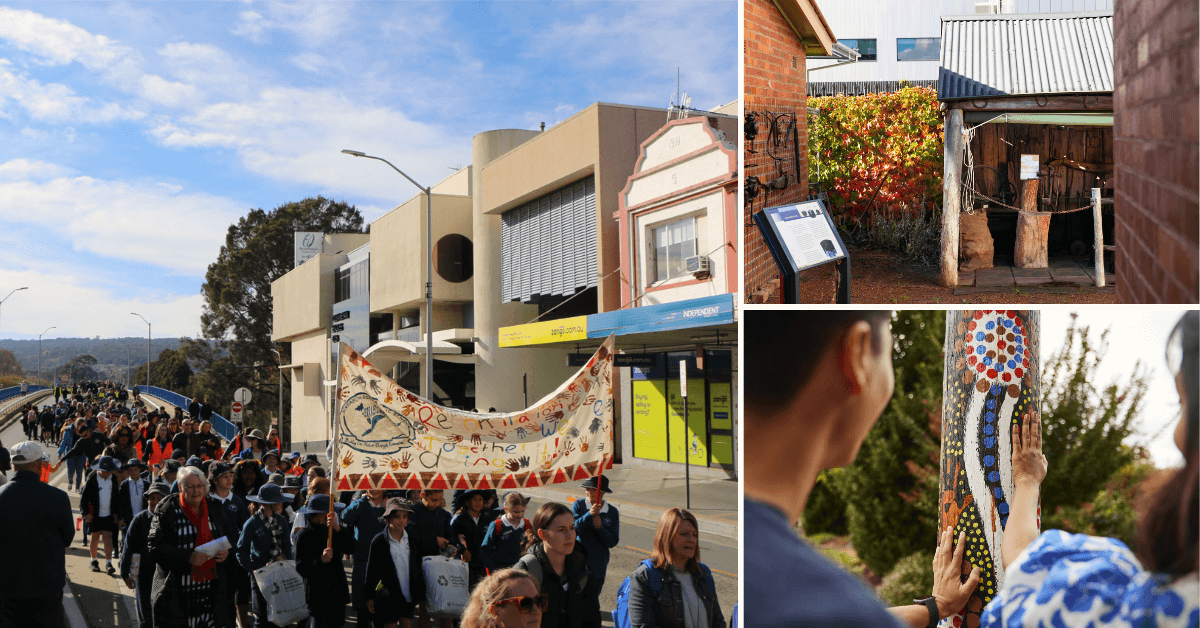Every year, Reconciliation Week runs from 27 May to 3 June. The two dates commemorate two significant milestones in the reconciliation journey: the successful 1967 referendum that led to the constitution amendment to include Indigenous Australians in the census, and the High Court Mabo decision that overturned terra nullius and recognised the native title rights of Indigenous Australians.
Reconciliation Week is a time dedicated to exploring how each of us can contribute to achieving reconciliation in Australia. The 2024 theme, Now More Than Ever, reminds us that the fight for justice and rights of Aboriginal and Torres Strait Islander people must continue. Below is how you can engage and connect this Reconciliation Week.
Annual Reconciliation walk
Each year, Queanbeyan-Palerang Regional Council holds an annual symbolic Reconciliation Walk that involves all schools across the region, along with local Aboriginal and Torres Strait Islander elders.
In a group of literally thousands, we start from Queens Bridge and continue along Monaro Street before ending at Queanbeyan Town Park, where there is typically a Welcome to Country before a flag-raising ceremony and dance performance.
Join us to recognise the contribution of Aboriginal people and support reconciliation – details of the 2024 Reconciliation Walk can be found on the QPRC Events page. Interested in learning more about QPRC’s Aboriginal and Torres Strait Islander programs? Visit the website.
As we get closer to Reconciliation Week, you can find more local events at nrw.reconciliation.org.au/calendar.
Queanbeyan’s Story Begins
Housed in a beautifully-preserved 1876 building, the Queanbeyan Museum exists to preserve and promote Queanbeyan’s history and heritage.
One of the permanent displays is ‘Queanbeyan’s Story Begins’, an exploration of the Ngambri people. Before settlement, there were around a thousand Ngambri people and their kin group, the Ngurnal people, living across the region; to them, Queanbeyan, the meeting place of two rivers, was known as Quinbean.
There were many other clans too and something that brought them all together every year was the arrival of the Bogong moth. Groups would gather together to hunt and gather the nutritious Bogong moth and to renew their relationships. It was an annual ceremony that underscored the interconnectedness of the land, the people, and their traditions—and you can learn more at the Museum. You can also learn about what followed 1820 when the first early settlers arrived in the region on horseback.
The Museum is entirely volunteer-run and only open on weekends from 1-4pm. Entry is free but donations are highly encouraged to help preserve Queanbeyan’s story.
Public Australian Indigenous Art
Our region has a strong commitment to public art, believing that it not only adds meaning to the built environment but helps our understanding of our cultural and natural heritage.
At Letchworth Community Centre, find the Aboriginal Mural, which is over 10 years old and was created by the children at the Aboriginal and Torres Strait Islander Playschool and their families. There is the Queanbeyan River running through the middle surrounded by local flora and fauna and it celebrates Queanbeyan as a meeting place for all members of the community.
At the Sensory Garden in Ray Morton Park, there are the Jullergung Totem Poles, a creation by several local Indigenous artists as coordinated by Matilda House. There are other artworks at the Sensory Garden too; it is part of the Queanbeyan Public Art Walk.
Written by Thuc Do, Fiction Agency, for Visit Queanbeyan-Palerang.

